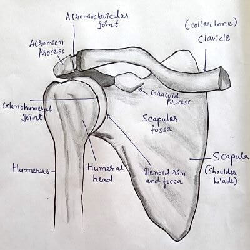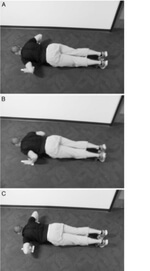
Proper scapulothoracic motion is necessary for the health and function of shoulder and it is principal focus in the rehabilitation setting.
Various types of push ups are used frequently during shoulder rehab as a closed kinematic chain exercise.
David and colleagues conducted a study to examine the effect of different shoulder position on scapular kinematics through the range of motion of a traditional push up.
They observed scapular kinematics during traditional push ups in three different shoulder positions,
1. Push-ups with regular arm position
2. Push-ups with adducted arm position
3. Push-ups with 90*abducted arm position

They observed three scapular movements
1. Posterior tilt (PT)
2. External rotation(ER)
3. Upward rotation(UR)…during push ups with above arm positions.

They observed that during push ups
Posterior tilt and external rotation decreased with arm elevation. Means when push ups performed with arm adducted PT and ER were maximum, and were least when push-ups performed with arm 900 elevation.
And upward rotation was greater with arm in less elevation.
Why this study is important?
The current study is the best of its kind to investigate how shoulder abduction influence scapular kinematics during the concentric phase of a push-up in pain- free individuals. The results of this study inspire considerations of the complex relationship between upper trapezius and serratus anterior in stabilization and positioning of the scapula. In the optimal selection of therapeutic intervention for individuals with shoulder pathologies, a lower upper trapezius to a higher serratus anterior and lower trapezius muscle activation ratio is desired, along with an increase in posterior tilting, upward rotation, and external rotation of the scapula during arm elevation. This is hypothesized to maintain optimal subacromial space and scapular position. The results of the current study suggest that as shoulder abduction increases during a push-up, posterior tilting and external rotation of the scapula decrease.
How does it affect practice?
The push-up is is one of the few closed- chain exercises for the upper extremity commonly used in rehabilitation. The current study supports the notion that the traditional push-up, performed at 90° of shoulder abduction, may result in scapular kinematics that decreases subacromial space (increased anterior tipping and internal rotation) and place stress on subacromial structures.
Clinical implementation:
Rehabilitation exercises in individuals with shoulder dysfunction should emphasize lower upper trapezius to higher serratus anterior and lower trapezius muscle activation ratios in an effort to enhance movement and positioning of the scapula during functional tasks.
Performing traditional push-ups in arm elevated position may place scapula in a position resulting in decreased subacromial space, possibly contributing to symptoms of impingement.
So while performing push-ups, arm elevation should be less than 60* in rehabilitation set up or gym.
- Reference:
Scapular kinematics and shoulder elevation in a traditional push-up.
Suprak DN, Bohannon J, Morales G, Stroschein J, San Juan JG


